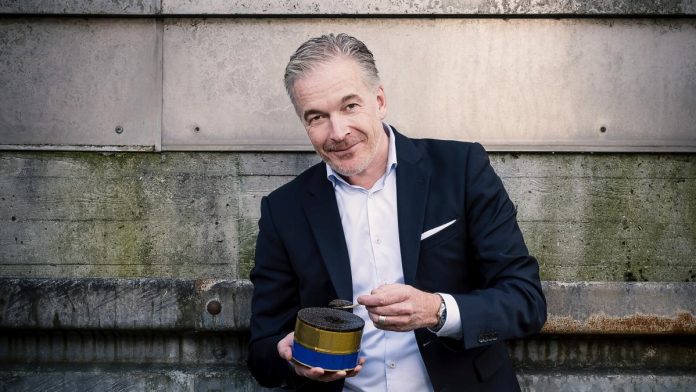Caviar is a classic luxury product. The Hamburg trading house AKI shows that the delicacy can be inexpensive and environmentally friendly. The boss, Markus Rüsch, does not accept any compromises in quality.
“It’s stressful here every morning,” shouts Markus Rüsch, and you can feel in every second how much fun he has just thinking about it. Rüsch is a wiry man, someone who talks a lot, a handshake type and an honorable Hamburg merchant. The headquarters of AKI (Altonaer Kaviar Import) has three floors. The small, almost hundred-year-old company, which Rüsch runs in the third generation with his wife Eva Pankalla, is one of the largest global players in the caviar trade. As always, trucks load the raw materials here early in the morning in 1.8 kilo cans. On the ground floor of the headquarters, the goods are inspected, selected, prepared and individually bottled. Only the hygiene standards are significantly different today than they were when Rüsch's father sat at the table and his mother did the bills. “We used to still have a meal here,” remembers the son, who has been with the company since 1984 and took over management in 2001. Today you have to wear protective clothing and the rooms are meticulously cleaned for about an hour and a half after production.
It's Friday afternoon, the stress is over. Rüsch stands in the empty production area, shows large refrigerators full of tin cans, the raw materials, goes to a kind of counter full of compartments with neatly sorted jars and lids, continues to a pasteurization basin for heating cans, to caviar, which is only mixed with salt, to make it more durable, and to another station where caviar – classically – is added with a little boric acid for the same reason. He hops over to machines that seal the cans or jars airtight, grabs a piece of paper as they are being filled. “Ah, that’s a good order,” he says. A cruise ship. “We will receive 200 kilos of caviar next week.”
AKI supplies three major shipping companies, but also exclusively the largest German airline. “Here, which is a special feature of ours, we really do the selection for our customers by hand.” The classic caviar from sturgeon is processed in the main company, for the other, especially what Markus Rüsch casually calls “the colorful stuff.” there is a second, larger production facility in Wöhrden near Heide in Schleswig-Holstein. The “colorful stuff” is “Heide-Trout Caviar” or “Keta-Salmon Caviar”, both very orange, or the honey-yellow “Pike Caviar”. AKI is a leader in the so-called trend caviar. There are three large caviar dealers in Hamburg, in addition to AKI, Dieckmann & Hansen and Caspian Kaviar. The Hanseatic city has traditionally been something like the “small secret world capital for the caviar trade”.
AKI was founded by Max Schuldt on April 1, 1925, who bought the caviar from Russian sailors in the port – his wife Anne delivered the goods on her bicycle. From 1963 onwards, nephew Gustav Rüsch and his wife Johanna, Markus' parents, took over and expanded the business. At that time, good contacts with producers from the Soviet Union or Iran on the Black Sea were crucial. Markus Rüsch also flew with his parents via Moscow to Astrakhan – and from there they took ships to the Volga Delta, where the sturgeons were caught, slaughtered and the sturgeon eggs were removed. From the mid-nineties onwards, this type of production was no longer up to date, and at the same time quality fell and prices rose. The product had a terrible reputation. And AKI only had seven employees at the time Rüsch junior took over.
Today there are 17 in Hamburg and 33 in Wöhrden, all caviar comes from aquaculture and breeding farms. “Here, try this,” says the boss and opens a can of “Caviar d'Aquitaine”. Classic design with sturgeon on a blue lid. Siberian sturgeon products from France – “the cradle of modern aquaculture”. China has also entered the business for a few years now and is now setting the “taste of the times” with lighter, milder caviar. Rüsch takes a potato chip, spreads some crème fraîche on it and a spoonful of the caviar. It is dark gray and tastes spicy and intense. “You don’t have to know how to cook to make caviar,” he says. The “democratization of caviar,” as he calls it, is his theme. Even as a dollop on the breakfast egg. He takes a lightly toasted triangle of white bread, spreads a thick layer of butter on it and piles a little light gray caviar on it from the “Black Selection”. It tastes milder, more buttery, “sloppy,” as Rüsch calls it. The caviar comes from white sturgeon farmed near Fulda. A favorite company.
In 2001, Rüsch himself did not believe that farmed caviar would one day be of as high a quality as wild-caught caviar. That's also why he had positioned his company more broadly, started with the “colorful stuff” and also occasionally does campaigns with retail chains – from Edeka to Penny to Lidl. He has no fear of contact at all. Caviar is a luxury product because of its origin and production, but Rüsch wants to win new customers. He is currently experimenting with packaging without gold lettering and a fish logo. “Pure” is preserved with sea salt alone and – short distances – comes from German breeding. “It's an attempt. Our form of modernization. But for me the most important thing is: the quality is top!” With toast, lots of butter – not to be despised.


